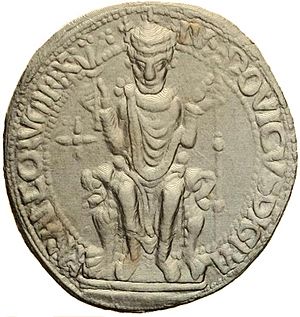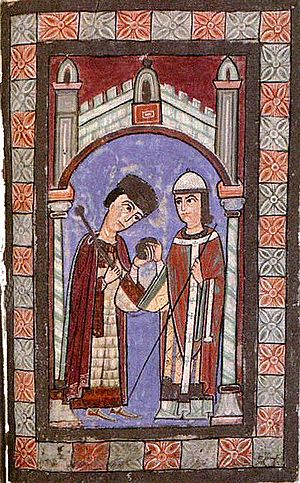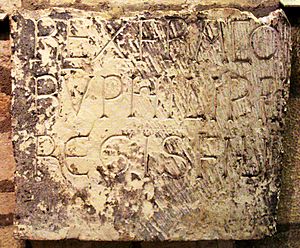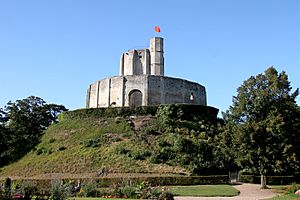Louis VI of France facts for kids
Quick facts for kids Louis VI |
|
|---|---|

Louis the Fat's seal
|
|
| King of the Franks (more...) | |
| Reign | 29 July 1108 – 1 August 1137 |
| Coronation | 3 August 1108 in Orléans Cathedral |
| Predecessor | Philip I |
| Successor | Louis VII |
| Born | late 1081 Paris, France |
| Died | August 1137 (aged 55–56) Béthisy-Saint-Pierre, France |
| Burial | Saint Denis Basilica, Paris, France |
| Spouse |
|
| Issue |
|
| House | Capet |
| Father | Philip I, King of the Franks |
| Mother | Bertha of Holland |
Louis VI (born in late 1081 – died August 1, 1137) was a powerful king of the Franks. He ruled from 1108 to 1137. People called him "the Fat" (French: le Gros) because he became very heavy later in life. He was also known as "the Fighter" (French: le Batailleur) because he spent much of his reign fighting to make his kingdom stronger.
Louis VI was the first king from the House of Capet to truly start making the royal government more central and powerful. He spent almost all of his 29 years as king fighting against unruly nobles near Paris. He also fought the kings of England who controlled Normandy. Even with these challenges, Louis VI greatly increased his power. He became one of the first strong kings of France since Charlemagne died in 814.
Louis was a warrior king. However, by his forties, his weight made it hard for him to lead battles. His loyal advisor, Suger, who was an abbot, wrote a book about Louis's life. It's called the Vita Ludovici Grossi Regis.
Contents
King Louis VI
Early Life and Family
Louis was born in Paris around 1081. His parents were King Philip I and Bertha of Holland.
Abbot Suger, who wrote about Louis VI, said that as a young man, Louis was very brave. He was more interested in fighting than in hunting or playing games like other boys his age. Suger also mentioned how bravely Louis fought against William Rufus, the King of England, who attacked Louis's kingdom.
In 1104, Louis married Lucienne de Rochefort. She was the daughter of his father's chief officer. However, they separated three years later and had no children.
On August 3, 1115, Louis married Adelaide of Maurienne. She was the daughter of Humbert II of Savoy. Adelaide was a very active queen in politics. Her name appeared on many royal documents during Louis VI's reign.

Suger became Louis's advisor even before Louis became king. Louis became king at age 26 on July 29, 1108. His half-brother tried to stop him from reaching Reims, where kings were usually crowned. So, Louis was crowned in the cathedral of Orléans on August 3.
Challenges to Royal Power
When Louis became king, France was made up of many small areas ruled by powerful nobles. The French kings had little power outside their own lands, called the Isle de France. But Louis slowly began to change this. He started to make the king's power stronger. This process took two centuries to finish, but it began with Louis VI.
Another big challenge for Louis was the growing power of the Anglo-Normans. These were people from England and Normandy, led by their strong new king, Henry I of England.
Fighting Unruly Nobles
From the start of his reign, Louis faced a problem with "robber barons." These were nobles who ignored the king's authority. They acted like bandits, making the area around Paris unsafe.
These barons would charge tolls, attack merchants and pilgrims, and steal from churches. This made the writers of the time, who were mostly churchmen, very angry.
Early Campaigns
In 1108, Louis fought against Hugh of Crécy. Hugh was causing trouble and had captured a count named Eudes. Louis attacked Hugh's fortress to free Eudes.
Also in 1108, a lord named Aymon Vaire-Vache took control of Bourbon from his young nephew. Louis told Aymon to give the land back, but Aymon refused. Louis gathered his army and attacked Aymon's castle, forcing him to give up.
In 1109, Louis attacked his half-brother, Philip, who was causing trouble and plotting against the king. Philip was working with other lords who controlled castles that blocked Louis's access to parts of his kingdom.
Later Campaigns and Notable Outlaws
In 1122, a bishop asked Louis for help because a count named William VI had driven him from his town. When William refused to obey Louis, the king gathered an army. Louis attacked William's fortresses and forced him to leave Clermont. The bishop was returned to his town. Four years later, William rebelled again. Even though Louis was very heavy, he marched his army again. He captured William and brought him to court to answer for his actions.
Some of these outlaws were known for being very cruel, like Thomas, Lord of Coucy.
Another famous outlaw was Hugh, Lord of Le Puiset. He was causing trouble around Chartres. In 1111, Louis heard complaints about Hugh from other powerful nobles and church leaders. Louis ordered Hugh to appear before him, but Hugh did not come. Louis took away Hugh's lands and titles. He then attacked Hugh's castle, burned it down, and took Hugh prisoner.
Louis made a mistake by releasing Hugh. While Louis was fighting Henry I of England, Hugh gathered more outlaws and started causing trouble again. Louis had to return and fight Hugh again. He burned Le Puiset down a second time. Hugh promised not to cause trouble again, but he rebuilt his castle and started terrorizing his neighbors once more. Finally, Louis defeated Hugh for the third time and took away all his possessions for good. Hugh later died on a trip to the Holy Land.
These were just some of the difficult nobles Louis had to deal with. There were many more. Louis was constantly moving his army from castle to castle, bringing law and order to his lands. Because of this, people started to see the king as their protector, and the king's authority grew stronger.
Wars with England
After becoming King of England, Henry I of England took control of Normandy from his brother. He also took the castle at Gisors. This castle was very important because it controlled the road between Rouen and Paris. This went against an earlier agreement that Gisors should be neutral or destroyed.
This move threatened the French king's lands. Louis was very angry and demanded that Henry, as his vassal (a noble who owes loyalty to the king), explain his actions. The two kings met in 1109. Henry refused to give up Gisors. Louis even challenged Henry to a single combat (a fight between two people) to settle the issue. Henry refused, and war began. This war lasted on and off for twenty years.
The first years of the war went well for Louis. But then, a powerful noble named Theobald II, Count of Champagne, switched sides to support Henry. By 1112, Theobald had brought together other nobles who were unhappy with Louis.
Louis defeated Theobald's group, but this extra effort meant he couldn't defeat the English king too. In 1113, Louis had to sign a treaty. This treaty recognized Henry I as the ruler of Brittany and Maine. Peace lasted for three years until fighting started again in 1116.
By 1119, Louis felt ready for a final battle. But in the fierce Battle of Brémule in August 1119, Louis's troops were defeated. The king himself had to retreat. Louis, whose health was getting worse, looked for peace.
He asked Pope Callixtus II for help. The Pope met with Henry in 1120. The peace terms included Henry's son, William Adelin, paying respect to Louis for Normandy. All lands captured by both kings were returned, except for Gisors. Louis had to let Henry keep Gisors.
Helping in Flanders
On March 2, 1127, the count of Flanders, Charles the Good, was killed. This caused a big problem because many relatives claimed to be the next count.
Louis had his own choice for the new count. He marched into Flanders with an army. He told the nobles to choose William Clito, the son of Robert Curthose, as their new Count. William had no strong claim to Flanders, but on March 23, 1127, the people of Flanders elected him.
Louis then acted quickly to secure Flanders. He caught the people who killed Charles the Good and removed the other people claiming the title. He took several towns and captured William of Ypres, putting him in prison.
Before leaving Flanders, Louis watched the execution of Charles the Good's killers. They were thrown from the roof of the church where they had committed their crime.
This was a great success for Louis. It showed how much stronger the king's power had become under his rule. However, it was a short victory. The new young Count William Clito did not rule well. He used old-fashioned feudal ways that did not suit the people of Flanders, who were more focused on trade. William's knights caused trouble, and the Flemings rebelled against Louis's choice.
Louis tried to help again, but it was too late. The people of Bruges rejected him and recognized Thierry of Alsace as their Count. Louis tried to stop Thierry, but it was just a gesture. Louis eventually gave up on William of Clito, who died in 1128. After all of Flanders accepted Thierry, Louis had to confirm his claim.
Invasion by Henry V

On November 25, 1120, Louis's luck against Henry I of England changed. Henry's son, William Adelin, died in a shipwreck while traveling from Normandy to England. This put the future of Henry's family and his power in doubt.
By 1123, Louis was part of a group of nobles who opposed Henry. Their plan was to drive the English king out of Normandy and replace him with William Clito. However, Henry easily defeated this group. Then, Henry asked his son-in-law, Henry V, Holy Roman Emperor, to invade France.
Henry V had married Empress Matilda, the English King's daughter, nine years earlier. He hoped to create a large Anglo-German empire. In 1124, Henry V gathered an army to march on Reims. But his army never arrived. This showed how much Louis had grown as a national protector. All of France united to fight against the threat. Henry V did not want to face all the French nobles united behind their king. Louis now identified himself as a loyal servant of St. Denis, the patron saint of Paris, whose banner he carried. The planned invasion was stopped.
Henry V died a year after this failed campaign.
Alliance of England and Anjou
In 1128, Henry I married his only surviving child, Empress Matilda, to Geoffrey Plantagenet, Count of Anjou. This marriage would create a dangerous alliance for Louis's son, Louis VII of France, in the future.
Final Years and Legacy
As Louis VI neared the end of his life, there were reasons to be hopeful. Henry I of England had died on December 1, 1135. Stephen of Blois had taken the English crown, breaking his promise to Henry I to support Matilda. Stephen was not in a position to bring the combined Anglo-Norman power against France.
Louis had also made great progress in making his royal authority stronger over his nobles. Even Theobald II had finally joined the king's side.
Finally, on April 9, 1137, a dying William X, Duke of Aquitaine chose Louis VI to be the guardian of his 15-year-old daughter, Eleanor of Aquitaine. Eleanor was suddenly the most important heiress in Europe. Louis quickly arranged for her to marry his own son, the future Louis VII. They married on July 25, 1137. With this marriage, Louis had added one of the most powerful areas in France to the Capetian lands.
Louis died of dysentery seven days later, on August 1, 1137. Despite his achievements, the growing power of the Angevin Empire would soon overshadow his successor. The seeds for this empire were sown in the marriage between Empress Matilda and Geoffrey Plantagenet, and it grew strong under their son, Henry II of England.
Louis VI was buried in the Basilica of St Denis in Paris.
Marriages and Children

Louis VI married twice:
- In 1104, he married 1) Lucienne de Rochefort. This marriage was ended in 1107.
- In 1115, he married 2) Adélaide de Maurienne (1092–1154).
Their children were:
- Philip (1116–1131), who was a junior king from 1129 to 1131. He died after falling from a horse.
- Louis VII (1120–1180), who became King of the Franks.
- Henry (1121–1175), who became Archbishop of Reims.
- Hugh (around 1122 – died young).
- Robert (around 1123 – 1188), who became Count of Dreux.
- Peter (1126–1183), who married Elizabeth, Lady of Courtenay.
- Constance (around 1128 – 1176), who married twice.
- Philip (around 1132 – 1160), who became Archdeacon of Paris.
Louis VI also had a daughter with Marie de Breuillet:
- Isabelle (around 1105 – before 1175), who married Guillaume I of Chaumont.
See also
 In Spanish: Luis VI de Francia para niños
In Spanish: Luis VI de Francia para niños
|
Louis VI of France
Born: 1 December 1081 Died: 1 August 1137 |
||
| Regnal titles | ||
|---|---|---|
| Preceded by Philip I |
King of the Franks 1108–1137 with Philip as junior king (1129–1131) Louis VII as junior king (1131–1137) |
Succeeded by Louis VII |



